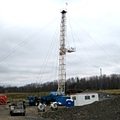- By -Staff
- News
 Print
Print  Hydraulic fracturing of shale is likely to be significantly less productive in New York than in Pennsylvania, while still creating widespread problems associated with ancillary activities such as water impoundments, compressor stations and waste disposal. That is the conclusion reached by a team of analysts and presented at a forum at Cornell University on Wednesday night.
Hydraulic fracturing of shale is likely to be significantly less productive in New York than in Pennsylvania, while still creating widespread problems associated with ancillary activities such as water impoundments, compressor stations and waste disposal. That is the conclusion reached by a team of analysts and presented at a forum at Cornell University on Wednesday night.“If New York allows high-volume hydrofracking in shale, I expect we will see quite a bit of test drilling, especially near the Pennsylvania border, though other locations can’t be ruled out. The more widespread impacts will be from infrastructure build-out and waste disposal,” said Lou Allstadt, former executive vice president of exploration and production for Mobil Oil in the US, Canada and Latin America.
“The Marcellus Shale gets thinner and shallower as it crosses the border into New York, resulting in significantly less gas production than in Pennsylvania,” said Jerry Acton, retired Lockheed Martin systems engineer, who analyzed production data from over 1500 Pennsylvania wells.
By analyzing Pennsylvania well productivity as a function of Marcellus Shale depth and thickness, Acton was able to project well productivity for similar Marcellus depths and thicknesses in New York.
The Marcellus Shale extends northeast from West Virginia through eastern Ohio, across most of Pennsylvania and into central New York. From central Pennsylvania it gets thinner and more shallow as it courses northward.
Acton’s analysis showed that the highest yields are seen where the Marcellus shale is deepest and thickest, at the intersection of Bradford, Susquehanna and Wyoming counties in Pennsylvania. Based on this comparison of geology to production levels, Acton projects that a few towns in New York’s Southern Tier will have below average productivity, while the rest of New York’s Marcellus Shale will have low to very low productivity.
Data from exploratory wells and industry investment activity in New York supports Acton’s projections.
“By 2008, a number of oil and gas companies drilled hundreds of vertical wells that either specifically targeted the Marcellus or Utica shales or which had to pass through them,” explained Allstadt. “Long before the de facto moratorium on hydrofracking came into effect in 2010, many industry players had already determined it wasn’t worth investing in New York shale plays, and they began investing elsewhere.”
“The remaining well permit applications listed by the DEC are largely concentrated in a small area near the Pennsylvania border. These southern tier areas will remain uneconomic as long as more productive wells are active in Pennsylvania and other states,” Allstadt stated.
“Surface restrictions, such as steep slopes, setback requirements and watershed protection areas further constrain where drilling can occur,” said Chip Northrup, retired oil and gas investor and former planning manager at Atlantic Richfield.
“Water withdrawals, compressor stations, pipelines, drilling wastes, road damage, and relatively little gas production; that is what to expect in New York if high-volume hydrofracking is permitted here,” said Northrup. “There will be little economic gain to offset the risks to water, land, air, municipal infrastructure and public health if hydrofracking in shale is allowed in New York State.”
v9i41
